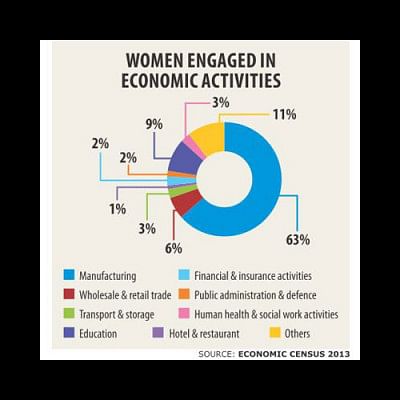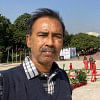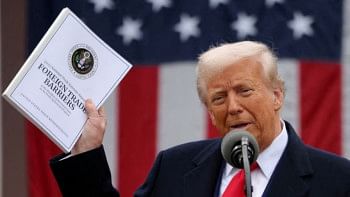Women's economic footprints are growing

Women-owned economic households increased six-fold in the last one decade as women push to break out from their traditional role as homemakers.
In 2013, the total number of women-owned economic households stood at 3.63 lakh in contrast to 62,255 in 2003, according to the Bangladesh Bureau of Statistics.
Households that have non-agricultural economic activities such as cottage industry, shops or workshops in or within their premises are classified as economic households.
Between 2003 and 2013, women-owned economic households increased 49 percent a year.
The disclosure comes as the World Bank in its last update on Bangladesh said the country is facing declining potential GDP growth to around 5.7 percent in fiscal 2016-17 partly due to falling labour force growth.
But there is potential to re-accelerate labour force growth by increased female labour participation, it added.
Poor women with no or little education, who previously stayed at home and engaged in cooking, are now taking up the management of the household, said a BBS official.
Women are getting various finances from the government and the non-government organisations, which resulted in their involvement in different economic activities, he added.
“We now know they can do almost everything that men can in an environment in which they can conduct their ordinary business of life with dignity and respect,” said Zahid Hussain, lead economist at the World Bank's Dhaka office. Women in Bangladesh have come a long way from being exclusively homemakers to entrepreneurs, workers, political leaders, opinion makers and so on.
For instance, the rapid rise in the number of women proprietors in the decade ending 2013 is a result of many governmental and social interventions that sought to bring women out of their homes and early wedlock into the mainstream economic landscape.
These included programmes for family planning, female stipends and awareness building and microcredit.
All these led to increased empowerment of women and destruction of numerous myths on what women can and cannot do, Hussain added.
Some 33 percent of the heads of the women-owned economic establishments are educated up to primary level and 31 percent passed the lower secondary level, according to BBS statistics.
Some 14 percent did not have any formal education, while only 3.94 percent are educated up to the graduate level or above.
Due to low levels of education among women, the number of women-owned permanent economic establishments has not increased much.
Permanent establishment is an economic unit outside the household with a fixed location and a permanent structure.
In 2013, women-owned permanent establishments stood at 59,793, up 38 percent from 2003. This means the average yearly increase was 3.8 percent.
The total number of persons engaged in economic activities is 2.45 crore, of which 83.46 percent are male and 16.45 percent female.
Of the 40.52 lakh women engaged in economic activities, 25.74 lakh are in manufacturing, largely the garment sector.
This figure implies that the males have strong dominance in the job market, while the females are still insignificant, said the BBS.
Full-time female workers stood at 30 lakh in 2013, a fourfold increase from 2003.
“While the gender barriers are breaking, there is still a long way to go. Women participation rate is still abysmal,” Hussain said.
“Women's participation diminishes rapidly as we move up the social, political and business ladders. The social, psychological and legal barriers to women's integration into the mainstream are far from being gone,” he added.

 For all latest news, follow The Daily Star's Google News channel.
For all latest news, follow The Daily Star's Google News channel. 



Comments